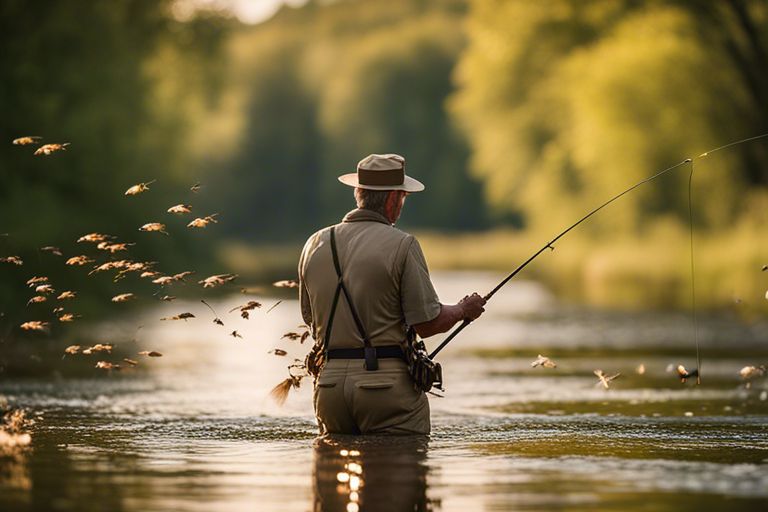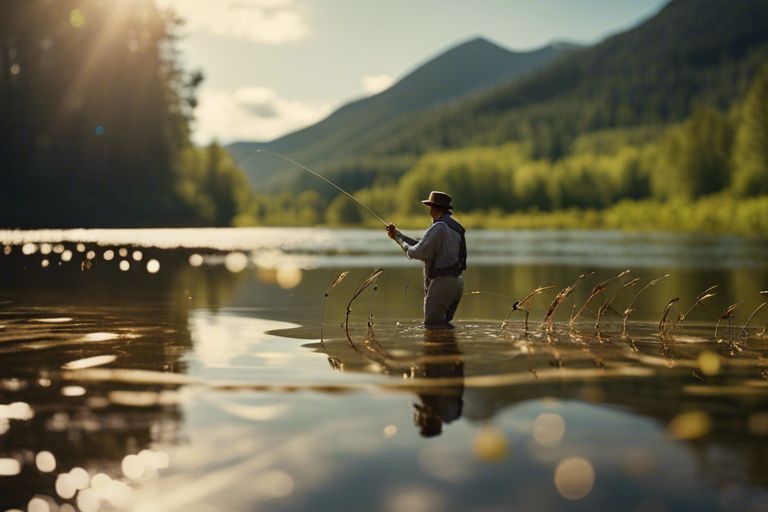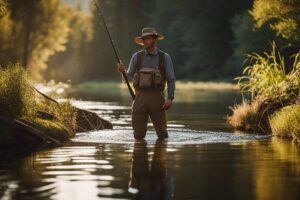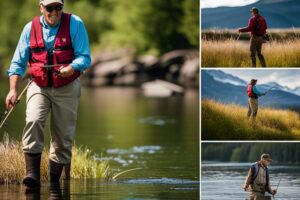There’s a rhythm to the waters you fish, and understanding insect life cycles is key to mastering it. The delicate balance of nature shapes the patterns of fish behavior, dictating when and how they feed. By learning about the life stages of aquatic insects, from nymph to adult, you’ll enhance your fly selection and increase your chances of a successful catch. Dive into the intricate world of insects and let their life cycles guide you to better fishing experiences.

The Basics of Insect Life Cycles
The world of insects is varied and complex, with life cycles that greatly influence their behavior and habitats. Understanding these life cycles is crucial for any angler seeking to improve their fly fishing techniques. Insects typically undergo metamorphosis, a process that transforms them from an egg into an adult. This transformation occurs through distinct stages, each of which plays a critical role in the overall life cycle. Familiarizing yourself with these stages will deepen your knowledge of insect behavior and help you choose the right flies for your fishing conditions.
Metamorphosis: The Four Stages of Insect Development
Stages of metamorphosis consist of four key phases: egg, larva, pupa, and adult. The cycle begins when an insect lays eggs, often in or near water sources. Once the eggs hatch, the larval stage emerges, where insects like mayflies and caddisflies thrive in aquatic environments. They feed and grow significantly until they reach the next phase, the pupal stage, where they undergo significant physiological changes. Finally, the adult stage is reached, marking the emergence of winged adults ready to reproduce.
This metamorphic journey is crucial for understanding insect behavior in relation to fly fishing. Each stage presents different characteristics and vulnerabilities, which directly influence feeding patterns and habitats. Your ability to recognize and interpret these stages can lead to more successful fishing outings, as you can better match your flies to the insects present in the water at any given time.
The Importance of Timing in Fly Fishing
Timing is crucial in fly fishing, as it determines when fish are most likely to rise and feed. Understanding the life cycle of insects and the timing of their emergence can give you a significant advantage on the water. For instance, during a hatch, fish will focus on the specific insect type present, and matching your fly to mimic the lifecycle stage—be it nymph, emerger, or adult—can make all the difference.
Development of your timing skills relies on observing environmental cues such as temperature, water flow, and seasonal changes. By noting when insects are most active, you can plan your fishing trips accordingly. When you align your efforts with these natural events, you maximize your chances of success, as fish are more likely to be feeding on the available insect life. Familiarize yourself with local hatches and understand how to read the water, and you will be better equipped for any fishing adventure.

Aquatic Insects
One of the most vital components of fly fishing lies in understanding the aquatic insects that populate our waters. These insects undergo remarkable life cycles that can influence your choice of flies. Knowing which insects are hatching at any given time allows you to match your flies to the natural food sources fish are targeting. Seasonal changes, water temperature, and local ecosystems dictate what insects you will encounter, making it imperative to observe and adapt. The most common aquatic insects include mayflies, caddisflies, and stoneflies, each offering unique challenges and rewards for your fishing endeavors.
Mayflies: The Most Imitated Insect in Fly Fishing
Aquatic insects have a profound impact on your fly selection, but mayflies are often seen as the crown jewels of these choices. They are not only abundant but also vary significantly in size, color, and behavior throughout their life stages. From the nymphs that reside on river bottoms to the delicate adults that dance above the surface, mayflies present myriad opportunities to create effective patterns. The iconic mayfly hatch is an event that draws anglers to rivers, as fish become voracious predators during this time. By using imitations that resemble emerging mayflies, you can better your chances of enticing a strike.
Caddisflies: The Underappreciated Aquatic Insect
An often overlooked group in the world of fly fishing, caddisflies flourish in varied aquatic environments and play a unique role in the ecosystem. Their life cycle is distinct, comprising several stages from the larval form, often encased in silk or debris, to pupation and adulthood. This adaptability allows caddisflies to thrive in diverse waters, making them integral to a fish’s diet. When you consider patterns to use, keep in mind that caddis imitations should mimic everything from the larval stages to the pupating ones. Fish will eagerly feed on caddisflies, particularly in the evenings when these insects emerge en masse, creating an exciting fishing opportunity.
Insect activity can be understated compared to mayflies or stoneflies, yet their importance in aquatic ecosystems cannot be ignored. Caddisflies excel in their abundance and varied habits, whether skimming the surface or diving just below. In many cases, they can provoke strong feeding responses from fish, especially when hatches occur in warmer months. To succeed in targeting caddis, pay attention to the water conditions and choose patterns that reflect the specific caddis species present.
Stoneflies: The Mighty and Elusive
Stoneflies remain one of the more powerful yet elusive groups of aquatic insects. These insects prefer clean, cold streams and serve as indicators of water quality. Their life cycle is longer than that of many other aquatic insects, with nymphs often dwelling in the streambed for a year or more. As a result, you will find stoneflies hatching in periods of higher water temperatures, usually in spring and early summer. When they do hatch, their large size and distinctively erratic movements make them highly visible to fish. Techniques such as using stonefly imitations can be particularly effective during this period, offering an enticing meal to hungry trout.
This extended life cycle can create a unique window for anglers. While you may often wait for the right hatch, stoneflies frequently linger in the nymph stage, giving you more opportunities to present your patterns effectively. Pay attention to their emergence patterns and mimic those through streamlined designs or erratic retrieves to catch the fish’s attention. Mastering the art of fishing with stoneflies can enhance your skills and increase your chances of a successful outing.

Terrestrial Insects
Not all insects flutter about in the air; many dwell on the ground, contributing significantly to the aquatic ecosystems you fish. Terrestrial insects become an vital food source for fish, particularly in still waters. Recognizing their lifecycles and presence can enhance your fly selection and improve your chances during outings. When you understand the intricacies of terrestrial insects, you unlock another layer to your fishing strategy.
Ants: The Overlooked but Effective Fly Pattern
Effective in various fishing conditions, ants are often dismissed by anglers. These tiny creatures find their way into the water, especially during rainy seasons or after disturbances in their nests. When you match the color and size of your flies to the ants that are prevalent in your fishing area, you can create an enticing meal for the fish. A well-placed ant fly can draw attention when other choices fail, making it a valuable addition to your tackle box.
When you cast an ant pattern on the water’s surface, it mimics a natural food source. Fish instinctively rise to take advantage of this often-bountiful offering. Pay attention to the time of year and the species of ants in your region. Casting during peak activity can lead to impressive results on the water, especially with subtle presentations that reflect the ants’ natural movement.
Beetles: The Diverse and Abundant Terrestrial Insect
Insects such as beetles yield a plethora of fishing opportunities. Some species are larger and more visible than others, making them prime targets for hungry fish. With their varied colors and shapes, beetles can be easy to imitate, and fish will often strike them with ferocity. When you encounter a particularly lush location, consider exploring beetle patterns in your fly arsenal.
Terrestrial beetles thrive in numerous habitats, from forests to fields, providing a steady food source during the warm months. When you incorporate beetle patterns into your fishing techniques, you capitalize on their abundance. Many fish species are attracted to these insects, thanks to their erratic movements on the water’s surface. Understanding the specific beetle species in your area enhances your chances, as different flies can better imitate the natural variations present in the local ecosystem.
Grasshoppers: The Summer Favorite
Overlooked by many anglers, grasshoppers offer a fantastic opportunity for effective summer fishing. These robust insects often leap into the water, providing a protein-rich meal for your target species. During the peak summer months, fish key in on these energetic hoppers. When
you present a grasshopper pattern accurately, it resembles a genuine snack to a hungry fish.
Abundant in grassy fields and along streams, grasshoppers can turn an ordinary fishing day into an extraordinary one. Their movements on the water can trigger instinctual feeding responses, leading to aggressive strikes. As the sun warms the day, grasshoppers become more active, and their presence in or near the water increases, making it vital for you to have a selection of grasshopper flies at the ready. This natural pattern can be the key to unlocking a hot day on the water, converting your efforts into memorable catches.
Insect Migration Patterns
Your understanding of insect migration patterns is vital for successful fly fishing. Insects do not merely drift on the current; their movements are intricately tied to environmental cues. This journey from water to sky, and back, is orchestrated by life cycles that align with seasonal changes, temperature, and habitat conditions. Recognizing these patterns empowers you to select the right flies at the right time, increasing your chances of a fruitful catch.
The Great Hatch: When Insects Take to the Skies
Patterns of migration during the great hatch attract fish as well as anglers. Insects such as mayflies and caddisflies rise en masse, transforming the water’s surface into a feeding frenzy. This event is more than mere coincidence; it is a behavioral strategy tied to survival. As insects emerge from their aquatic nymph stages, their journey into the air symbolizes both the continuation of their species and an invitation for you to engage with the sport of fly fishing. Timing is everything, and a keen eye can lead you straight to the best fishing spots when these hatches occur.
Understanding the timing of these hatches goes beyond mere observation. You must consider environmental variables that trigger these migrations. Factors such as light, water temperature, and nutrient availability all play significant roles. Insects have learned to synchronize their emergence with these elements, and so should you in your fishing approach. Plan your outings around these events for optimal success.
The Importance of Water Temperature in Insect Migration
Great changes in water temperature can dictate the rhythm of insect migration. Insects are cold-blooded, and their activity is directly influenced by the temperature of the water they inhabit. Generally, as temperatures rise in spring and summer, insects become more active, prompting migrations that coincide with their life cycles. Heed the temperature readings, and you’ll find the best times to pursue your fishing endeavors. The interplay of temperature and insect behavior guides the fly selection as certain species emerge at specific thermal thresholds.
Factors Influencing Insect Migration Patterns
| Factor | Impact on Insect Migration |
|---|---|
| Water Temperature | Stimulates insect activity and emergence |
| Light Levels | Affects the timing of hatches and migrations |
| Habitat Changes | Influences where insects migrate and breed |
| Nutrient Availability | Attracts insects to suitable environments |
This understanding of temperature’s role is crucial. To fish effectively, you must monitor the conditions closely. Water that is too cold may delay insect activity, while warmer water can prompt an explosion of life. Your fly selection should reflect these realities. Choose patterns that imitate the insects in their active phases. Flies that mimic emerging or adult stages will be your best options during these migration events.
Thermal Preferences for Common Insects
| Insect Type | Preferred Water Temperature (°F) |
|---|---|
| Mayflies | 58-70 |
| Caddisflies | 60-75 |
| Stoneflies | 46-60 |
| Midges | 50-66 |
With these insights, consider your strategy as you prepare for your next outing. Pay heed to temperatures, hatch timings, and insect behaviors, and you will find your fly fishing experience enriched. Follow the patterns, and your efforts in selecting the right flies will be rewarded with success on the water.
Fly Selection Based on Insect Life Cycles
Unlike many aspects of fly fishing that can rely on guesswork, selecting the right fly based on insect life cycles requires an understanding of nature’s patterns. Insects undergo various life stages, from egg to nymph to adult, each presenting distinct characteristics that you must replicate. Matching your fly to the specific life stage that fish are actively feeding upon is paramount. When you align your choice with the natural events in the water, you engage in a practice known as “matching the hatch,” which is as much an art as it is a science.
Matching the Hatch: The Art of Imitation
An effective imitate must resemble more than just the physical appearance of the insect; it must also mimic its behavior on the water. Pay attention to the way mayflies or caddisflies dance upon the surface; your fly should emulate that movement. As you observe the water’s surface, determine which insect is prevalent and select a fly that closely resembles it, right down to the size and color. This attention to detail can significantly increase your chances of a successful catch.
As summer progresses, the abundance of insects changes. Know when mayflies are hatching and in what colors they appear. Matching these changes will improve your presentation, transforming your efforts from mere luck into a strategic approach. Bear in mind, the more precise you are, the more effective your imitation will be, thus enhancing your overall success on the water.
Reading the Water: Identifying Insect Activity
Imitation alone is not enough; you also need to know where and when to fish. Observing the water closely will provide vital clues about insect activity. Look for rising fish and the movement of insects at or near the surface. Are there specific areas where insects are concentrated? Is there a particular time of day when they seem most active? Each detail can guide you in selecting the right fly and presenting it effectively.
Insects have different behaviors depending on their life stages. Pay close attention to swarms of flying adults, as they are often a target for hungry fish. If you’re seeing nymphs crawling on the bottom or adults fluttering at the surface, you know which stages to replicate. Understanding these patterns will elevate your experience and success in fly fishing.
Adapting to Changing Conditions
The environment can greatly affect insect activity, which in turn impacts your fly selection. Weather changes, water temperature, and even barometric pressure can lead to shifts in insect behavior and availability. For instance, a sudden drop in temperature may delay hatches, while an increase might prompt a surge in insect activity. Being adaptable and staying aware of these shifts can significantly improve your angling strategy.
As the day progresses into evening, switching your approach may become necessary. If you notice diminished insect activity, it may be time to transition to a different fly type. Being prepared to change your selection based on real-time observations will keep you in tune with nature and enhance your success on the water.
Selection of your flies should be a careful consideration of environmental factors and insect life cycles. The more informed you are about the insect life and their habits, the better equipped you will be to choose the right flies at the right times. Ultimately, this knowledge builds on itself and leads to more rewarding days on the water.
Strategies for Success
Many anglers find that success on the water often hinges on their ability to understand and adapt to the life cycles of insects. These cycles dictate when specific insects hatch, their abundance at certain times, and the behavior patterns that can influence your fishing strategy. By stepping into the details of an insect’s life—from the nymph stage through to adult emergence—you can pinpoint the optimal conditions for a productive day on the water. This knowledge serves as a critical compass, guiding you in selecting the right flies and techniques to enhance your fishing experience.
Observing Insect Behavior on the Water
For any angler, observing insect behavior on the water is necessary. Spend time watching the surface for emerging insects, as well as those resting or directly involved in mating rituals. Note the time of day these activities peak, as well as environmental factors such as temperature and wind, which can influence insect activity. Pay attention to the size and shape of the insects you see—it’s these observations that will inform your fly selection, making your approach more strategic and effective.
For example, if you notice a strong hatch occurring, you might see mayflies dancing on the surface or caddisflies skimming across the water. Matching these observations with your fly choices will increase your chances of enticing fish to bite. Recall, regular monitoring gives you insights into when to change tactics. Just as you would adapt your approach based on the changes in the weather or water conditions, so too must you be flexible with your fly strategy in response to the insects you observe.
Adjusting Fly Size and Color to Match the Hatch
Success in fly fishing often comes down to your ability to adjust fly size and color to match the hatch. If you see a particular hatch of insects, replicate their size and shades to make your artificial flies more enticing to fish. When insects emerge, they come in various hues and dimensions, and integrating this reality into your selection will yield better results. Your aim is to create a visual cue that replicates what fish expect from their prey.
This attention to detail not only applies to matching the general characteristics but also to understanding seasonal changes in insects. A light-colored fly might work well in early spring, while darker patterns may be more suitable as summer progresses. Seasonal variations can drastically change what you see on the water and how fish behave. Being goal-oriented in your fly choices allows you to stay ahead and keep your gear relevant.
Fishing the Right Depth and Speed
Water temperature, flow rate, and the specific behavior of insects will dictate how deep and how fast you need to fish. Depending on the life stage of an insect, fish may be found at various depths in the water column. For instance, nymphs often dwell near the bottom, while adult insects are typically found drifting near the surface. By adjusting your fishing techniques—such as the positioning of your nymphs or the speed of your retrieves—you can more effectively imitate the natural behavior of insects, leading to a higher chance of success.
Right now, consider the importance of finding the optimal depth at which fish are feeding. If your flies are too high or too low, you may miss opportunities. Changing your method, whether you use a heavier weight to sink deeper or a slower retrieval to simulate an insect’s natural drift can make all the difference. As conditions fluctuate, keeping a variable approach ensures that your tactics will be as adaptive as the insects’ life cycles on which you’re relying.
Summing up
As a reminder, understanding the intricate life cycles of insects is paramount to your success in fly fishing. The transformation of insects from nymphs to adults plays a critical role in determining what flies you should select on any given day. Recognizing the timing and presence of various stages, from hatches to periodical spawns, equips you with the knowledge to align your fishing strategy with nature’s rhythms. This awareness sets the stage for a fruitful fishing experience, as you master the art of matching the right fly to the right moment.
Your journey in the world of fly fishing will always benefit from a deeper understanding of insect life cycles. As you gain insight into the habits and movements of these creatures, you will find yourself more in tune with the water and its inhabitants. Engaging thoughtfully with these patterns transforms your fishing escapades into a more rewarding pursuit, capturing the essence of nature while honing your skills as an angler. Embrace this knowledge, and let it guide your choices as you cast your line into the waters.
FAQ
Q: How do the life cycles of insects influence the timing of fly fishing?
A: The life cycles of insects play a crucial role in determining when fish are active and what types of flies will be effective. Insects generally undergo several stages: egg, larva, pupa, and adult. Each stage is associated with different times of the year and environmental conditions. For example, mayflies are most active during warmer months, emerging from their aquatic larval stage to mate and lay eggs. Knowing when these insects hatch can help anglers time their fishing trips for peak activity periods, using appropriate flies that mimic the aquatic stage of the insects, which are usually more successful in attracting fish.
Q: What types of flies should be used to match specific insect life stages?
A: Anglers can improve their chances of success by selecting flies that correspond to the life stage of insects that are currently prevalent in their fishing area. For example, during mayfly hatches, dry flies that replicate adult mayflies can be highly effective. Similarly, when caddisflies are in their larval or pupal stages, nymph or wet flies imitating those life stages should be used. Understanding local insect life cycles enables anglers to choose flies that closely match the natural food sources available to fish at that time, enhancing their effectiveness.
Q: How do environmental factors affect insect life cycles and consequently fly selection?
A: Environmental factors such as water temperature, flow rate, and seasonal changes significantly influence insect life cycles. For instance, warmer water temperatures can accelerate insect hatching times, leading to important feeding windows for fish. Changes in precipitation can also affect water levels and the availability of certain insects. If conditions are favorable for a particular insect hatch, anglers should adapt their fly selection accordingly to match the active life stages. By staying attuned to these environmental changes, anglers can enhance their fly selection and fishing strategy throughout the fishing season.


